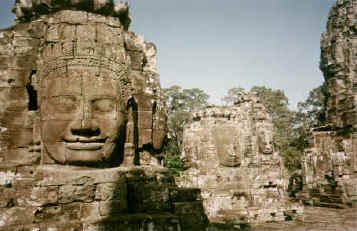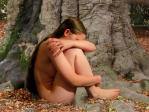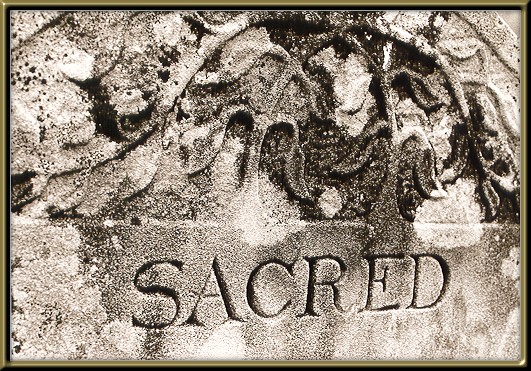|
Disclaimer: This unedited, rough draft material is a year-long project in response to our 2004 theme: pilgrimage. It is meant to be a dialogue between myself and my fellow Mammoths and any of you who happen along. It is intentionally not polished, nor is it finished. Charlie Buchman Ellis -------------------------------------------------------------------------------- Yesterday, when we had thunder and lightning, Tira came back, just for a moment. She died last year, a seizure disorder. She was a sweet, loving dog and I miss her. She had a phobia, thunder and lightning. I had to know where she was whenever we had thunder. She panicked—every time. In her panic she would vault fences, claw her way into open cars and trucks, cut herself trying to get out of a crate, trying to get out with the strength of a crazed 150 pound dog. I went out one morning about 3 AM, a storm had come up, and I worried about her. When I opened the door into the garage, I saw Tira, blood dripping from her jaws and head and hanging half over the gate we use to keep the dogs out of the garage. She had clawed her way up and over it, but a hind leg had gotten caught in the chain link mesh. She had tried to pull herself on over by gripping the trucks license plate with her teeth. The license had holes punched all the way through it. The hood of the truck had scratches from where her frantic attempts to gain purchase and get off the gate had failed. Without thinking I put myself under her and lifted her off the gate. Mind you, she weighed as much I did. I set her down gently, afraid she was dead. She whimpered and a sense of relief rushed through me. The blood came from a cut lip, a lip she had slashed in her attempt to pull herself on over using the license plate for purchase. Like the radar you develop with small children, I had to know where she was when a storm came. Yesterday, I wondered where she was. Then I remembered. I miss her. And Tully and Scot and Celt and Sortia and Morgana and Buck and Iris. I miss each one of them, not every day, but sometimes, you know, like when it storms. Heaven is where all the dogs you’ve ever loved and whoever loved you come to greet you after you die. Works for me. Now this may seem, on the surface, to have nothing to do with pilgrimage, but it does. Living with several different dog packs has taught me many things. Two of the most important are: each dog is an individual, as much an individual as a person; and, animal lives, at least mammals, are precious like ours. I did not come to these realizations suddenly, they have developed over many years and over relationships with many dogs—thirteen all together counting Tor, Orion, Emma, Hilo, Kona, and Bridgit. Here’s how this experience relates pilgrimage. On the sacred journey we call this life, I’m back to the eternal spiral metaphor I introduced a while ago, we find the numinous on the road, especially as one writer pointed out, at crossroads. In the case of dogs my journey has crossed the life of thirteen and the death of seven. In their lives and in the mystery of their death I have seen the universe unfold, small puppies grow into mature, defined individuals, capable of social interaction, of affection, of hurt, sadness, anger, frustration, joy, delight, love, satisfaction. The Romans believed each crossroads had its god and there were priests who tended the crossroads gods. I’m not sure which gods attend to the intersection between dog’s lives and human’s lives, but they must be gods of great compassion and wisdom This is one of the tasks we have on our pilgrim roads: to notice the work of divinity in the ordinary things along the way. Food. The weather. Our family. The garden. The strangers we meet on the Way. I write this with Sonny Rollins playing Blue 7, a candle illuminating the keyboard, and rain beating gently on the sliding glass door. I hope somewhere Tira’s made her peace with the storms and runs free, happy again.
Wretched Excess
A while back I wrote, and subsequently lost, a riff on the hyena lurking in the jungle of my mind. It’s there, sniffing, even as I write this. This hyena is a carrion eater, a bottom feeder, a rank opportunist, as predators are. It looks for the young, the injured, the old in my inner herd and if the herd’s protection lapses, it closes in for the kill. This lurker in the dark recesses is obsession, the underlayment for addiction; the part of my mind willing to sacrifice all for the sake of satiety. It is the true source of the AA saying about alcohol: cunning, baffling, mysterious. With animal cunning it will take a moment’s weakness: sadness, despair, physical pain, desire and turn it into a lifetime of hell. Why would a mind, a psyche do this to itself? Baffling. Downright baffling. The puzzle wrapped in enigma. Mysterious. Yes, somewhere deep in the obsessive jungle, where the hyena prowls, lies a guarded seldom-found path to the sacred. The problem is, like the labyrinth at Knossos, the way has a guardian beast, this predator who will kill you, make no mistake about it, if you falter along the way. Who will give us the thread to follow? Who will lay down the bread crumb path, mark their scent on tree and rock so we can orient ourselves when we get lost? The Buddha? Jesus? Emerson? Einstein? Whitman? Teresea? Hildegard? Underhill? Bill W.? Jung? The church? Adam Smith? Homer? Ovid? Your spouse? A parent, perhaps? A friend? When the student is ready, the teacher appears. The hyena can keep you from ever being ready. This is it’s goal. It wants to devour all of you, piece by piece. It takes what it can; it’s patience is life-long; it will take you, all of you when it can. It is the Cyclops at the entrance to the cave; Circe ready to transform you into a pig and keep you from your ship. The answer, the only answer, to who will be our Ariadne, is—you. This seems like Buddha-nature, which must be awakened. Or, the imago dei, which must be acknowledged. Or, the Self, which must be found and followed. In the end, or, is it the beginning, we must pick up our own ball of thread and wind thread out behind us as we keep watch for the Minotaur. We must know the Buddha, absent from this plane of existence, now resides within us, perhaps in sacred conversation with Yahweh or Jesus Christ, in whose image we can discover salvation—which is really the path to the sacred which leads past the hyena, or whatever is the hyena for you. We never kill our hyena, it is always ready, waiting, but we can keep it at bay, make it stand aside as we follow the sacred path it has hid all this time. A path only you can walk.
Monday Paul Strickland and I had lunch today at Origami, a sushi place near the Hennepin Avenue Bridge and the Grain Belt Sign and Charlie Haislet’s new digs. Weird for me because I had friends who lived in a loft in the second floor space where Paul and I ate. Used to be when I visited Fran and Ted I didn’t have to pay for lunch. A bar and a chef changes everything. Going to lunch at a place like Origami has a powerful resonance for me, not like the thunderstorms, yet powerful nonetheless. I used to do almost all my socializing over breakfast and lunch. It was often in the guise of meeting for this project or that, but the lunches always had a social side, too. In fact, the social side lubricated the work side. I imagine you know what I mean. It was good to eat lunch with Paul, discuss matters of faith—biblical interpretation, the power of the church’s hold on our hearts, the strange world of ecclesial politics. We talked about friendship and brotherhood, wondered if maybe the Woolly’s should discuss these topics, too. We both had some raw fish. Kate cringes at this since she knows the articles about toxins and wee creatures in uncooked anything. I also had a salad with octopus, Kate loves the little critters so I try not to eat them in her presence. (Though I must admit she’ll read this, so she’ll know.) Before I went to meet Paul I made my first foray into a DickBlick arts store. Oh, my. This art thing has soooo many possibilities. I don’t know whether to hope I improve or whether to hope I don’t. It could get expensive. But worth it. I found a Nepalese hand-made journal—hand made paper and cover and binding. I’m trying out journal styles to find one durable enough, light enough, and yet with good quality paper for my trip in the fall. A Nepalese article seemed too good to pass up. After I bought it I spent forty-five minutes in a Starbucks doing a not-too-bad drawing of a chair, a newspaper rack and a Denny’s sign. My goal with the art is to achieve a deeper bond between myself and the world I see. I want the memories to go deeper, and the physicality of the places I visit to stand out more clearly. I wonder, can I become intimate with the architecture of Singapore, the streets of Bangkok, especially the temples of Angkor? It’s interesting, but an effect of the drawing classes and the practice (I’m keeping this Nepalese journal now as I plan to keep one on the trip.) has pushed me to modify my thinking yet one more time. I’m not sure I’ll do it, but I’m considering only going to Singapore, Bangkok, and Angkor. If I do, it will be to have time to draw, to sit, to meditate, to become as much a part of the place as I can in a short period of time.
Both common sense and past experience suggest longer in a place is better, if it has the umphhh to sustain interest of course. I’m not sure yet, but I think all three places probably do. If so, I’ll go for the richer and deeper experience over the broader, yet less engaged trip. Even as I write this, I can feel my inner life saying—go slow, stay longer, pay attention. Breathe deep. See. Draw. Meditate. Strange, but these decisions need to get made now, as best I can, because they impact the ticket-buying, arrangements with Mark and Mary, and with anyone else who’s along. Drawing seems like a different way to enter a space, so different from taking photographs. It feels more congruent with me, slower, older, somehow, for me at least, more respectful. I know many people create art with their cameras, but I often used the camera to keep a distance between me and what I saw. I don’t want that distance on this trip.
The following is in response to the questions from Tom.
“My own pilgrimage exploration takes me again
and again into the concept of sacred...
Well...the big question. One I find people assume they know the answer to, but, when pressed, have no clue.
In reflection on this after posting it here, I realized I didn’t say one important thing. Experiencing the sacred what? It is my conviction we have hard wiring to experience the sacred. So, accessing it begs the question of its genesis. Now, its connection with words like holy, sacrament, mysterium tremendum, awe, wonder, and its common use in religious contexts from Islam to Hinduism suggests a supernatural, or at least divine origin. That is, the sacred is the felt experience of that which moves and wriggles just below (or above) the usual level of our perception, that something we frequently call God, or the divine. Perhaps so, but I don’t believe an experience of the sacred necessarily links to the supernatural, or the divine, or even spirit (a word somewhat opaque to me, I admit.)
This I know for certain: we are animals, and
as animals this earth is our home. "There are no passengers
on spaceship earth. We are all crew." -
R. Buckminster Fuller In this
gross body sense the sacred is, it seems to me, to participate as an
animal with our home. To love our home and to care for it. To experience
mutuality in that care because, in the end, as the Iroquois medicine man
said at Maryknoll College in Detroit so long ago: “The two-leggeds are so
fragile; they depend on everything else to survive. So, if we care for
everything else, we take care of the two-leggeds.” For the expression of our uniqueness which transcends the limitations of the Self/body link—who knows? I have intimations, but how to translate them into language? Perhaps the sacred places we visit have a distillation, an essential oil of this possibility. And, surely, it too would feel sacred.
Longing for the Divine: at the Swedish Institute? You never know. The Swedish Institute, built by a Swedish language newspaper magnate named Turblad looks like a castle, has dark, heavily carved wood throughout, plaster ceilings that make rococo look modest, and stained glass windows of finer quality than most downtown churches. The auditorium where the Minneapolis Art Institute held its Diversity Dinner was down a warren of corridors a badger could have found confusing, let alone all the gophers headed there. Early in the evening I debated, for the first time I can recall, whether my knees made climbing the steep steps from the basement to the third floor exhibition just too much. I’m working on this, but it is, right now anyhow, more than a nuisance. However, as always in my life, curiosity won out over apparent limitation. I climbed the stairs and Beverly Cottman was there, yelling up at Iri Shiriashi, “How much money is in that barrel? How much does the whole window cost?” This was the diversity evening in miniature: Beverly, an African-American retired science teacher cum artist cum storyteller, yelling up to Iri, an immigrant Japanese woman, to explain the intent behind a Swedish newspaper man’s opulent stain glass window. Beverly and I wandered around the exhibit talking about Michelangelo and the Sistine Chapel and wood-carving. Then Sheila McGuire came and called us to dinner. The dinner, Swedish meatballs, gravy, boiled potatoes, and cooked petite carrots was wonderful. I even put lingonberry jam on my meatballs as the nice blonde haired lady behind the counter advised. It tasted like jelly on meatballs. Oh, well... Anyhow this is all to give you an idea of the flavor of the evening before the Raj Mahal dancers took the stage. In spite of daunting technical difficulties that wiped out some of their music, the two dancers who performed proceeded to blow my mind. You may, or may not know, I did modern dance in college. I liked it a lot, even followed it up a bit with dance in seminary theatre. Since then...Nada. I don’t go to much dance, and I don’t know why, because it grabs me at a visceral level. These dancers, with elaborate and choreographed movements, told stories, ancient stories of gods and devotees, of creation and destruction, of worship. And of longing for the divine. The woman who explained the dances elaborated on one dance, an interaction between a devotee and Parvati, while the technical difficulty got resolved. She described this dance, which she and the woman who performed had studied for over seven years as “...difficult for Westerners to appreciate.” Not Indian herself, she included herself and the dancer among those Westerners. The dance, like many Hindu devotional dances express the longing of the worshipper for the diviner, often allegorically through the love of a man and a woman. In this case however the worshipper of Parvati, consort to Shiva, longed for relief from life. He wanted release from marriage and children which had become a burden and desired permission from Parvati to cross the river into death. It was the man’s desperation and despair that was difficult to grasp for this young woman and her dance colleague. I get it. In our Western demythologized, desupernatured, antimetaphysical, oh so empirical world, our religious beliefs have little ontological ooomph. How can we despair this life, when there is no other? How could anyone find themselves desperate to the cross the river, to leave family and children behind, not out of depression, but out of yearning for union with the divine? We have been taught that pie in the sky, by and by, when we die, was a cheap charlatans trick, used by generations of Elmer Gantry’s to relieve the gullible of their spare change. Or, we’ve made fine intellectual distinctions that have stripped away the curtain, or so we think, and revealed the not so great and powerful Oz behind the emerald green curtain. This is our poverty. A poverty, in the end, worse than any material poverty. Material poverty can be alleviated, or, it can be endured, but poverty of the spirit has no where to turn; it defeats the notion of endurance, it traps us in despair and desperation—if we are honest about the existential situation, i.e. we live alone and we die alone. And if we are not honest, the only solace we have is the true emerald green curtain. The problem is, Dorothy, we are in Kansas and we can’t get out. So many of us now know the plight of Parvati’s worshipper. We are desperate, in despair—yet we have no river to cross, no divine to yearn for. We have the allegory without the referent. For me, I have a pilgrim heart, one on the road always, looking for the river, looking for a bridge so I can cross back and forth, go in union with the sacred, then return to this life, back across the river, return. I am not desperate, nor do I despair, at least not now, not today, not tonight—but I do yearn, long for the divine, and I found fellow travelers, pilgrims from across the centuries in faraway India, who share my longing. Namaste. Charlie Buchman Ellis Top < Previous Next > |



